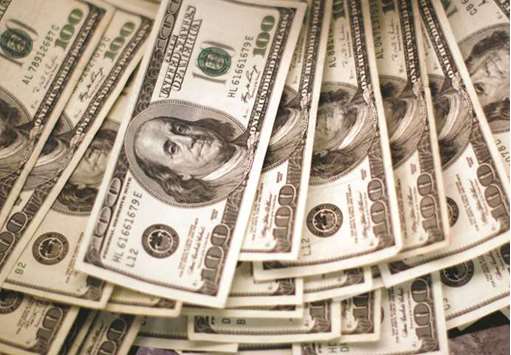The dollar and Treasury yields are sinking practically in unison, in a strengthening relationship that’s reverberating across financial markets.
The Bloomberg dollar index is the weakest since October, while 10-year yields are plumbing depths last seen in the days after Donald Trump’s November election.
Since his victory, the correlation between the greenback and yields has risen to 0.68 – where a reading of one indicates movement in lockstep. The synchronised fluctuations are a contrast from the pattern seen throughout 2016 up until Election Day, when the correlation was 0.03, indicating almost no discernible pattern.
Kit Juckes at Societe Generale describes the link as “stupidly strong.” Yet he sees a simple and smart explanation. It comes down to fading optimism that the administration will pass measures to boost economic growth and inflation, and the follow-through effects on expectations for Federal Reserve policy. With other major central banks staying accommodative, that leaves traders focusing on the US as the driver of currency and bond markets.
After the election, “it was all about what the Trump presidency implied for growth, fiscal policy and monetary policy,” Juckes, chief FX strategist at SocGen in London, said in a telephone interview. “We’ve seen a lot of excitement about where bond yields might go and how high the Fed policy rate might get fade away. That has certainly eaten away at the dollar.”
Betting on a dollar rally was the most crowded trade in global financial markets earlier this year, as the greenback surged with US yields after the election.
As the so-called Trump trade faltered, the currency has since experienced an about-face, weakening in four of the first five months of 2017. The euro has taken on the mantle of favoured currency of late, with hedge funds and other large speculators building the biggest bullish wager in more than six years. Europe’s shared currency has gained about 7% versus the dollar in 2017.
Investors in emerging markets are also big winners from the dollar’s slump. The MSCI Emerging Markets Index, which has soared almost 18% this year, could extend gains since a weaker greenback drives carry trades and reduces the burden on companies across Latin America, Asia and Eastern Europe, which have loaded up on dollar debt.
As US yields drop, narrowing rate differentials are undermining the greenback. The yield spread on 10-year Treasuries over similar-maturity bunds is about 1.9 percentage points, near the narrowest since November. The gap over Japanese government bonds is 2.1 percentage points, down from a seven-year high set in March.
Even as the dollar and yields have entered uncharted territory for 2017, the consensus on Wall Street is that a rebound is ahead. Among reasons cited: the prospect of quicker economic growth this quarter and suggestions from Fed officials that they want to start shrinking the central bank’s balance sheet.
Adding to the conviction that the rally in Treasuries may run out of steam at least temporarily, the 10-year yield is brushing up against a double-Fibonacci support level at 2.13%, which represents the 38.2% retracement of the increase in yields since July.
Taking a longer-term view, 10-year yields will rise to 2.8% by year-end, from 2.15% on Tuesday, according to the median forecast in a Bloomberg survey. Similarly, strategists see dollar-yen jumping to 115, from about 109.40 now.

The Bloomberg dollar index is the weakest since October, while 10-year yields are plumbing depths last seen in the days after Donald Trump’s November election


